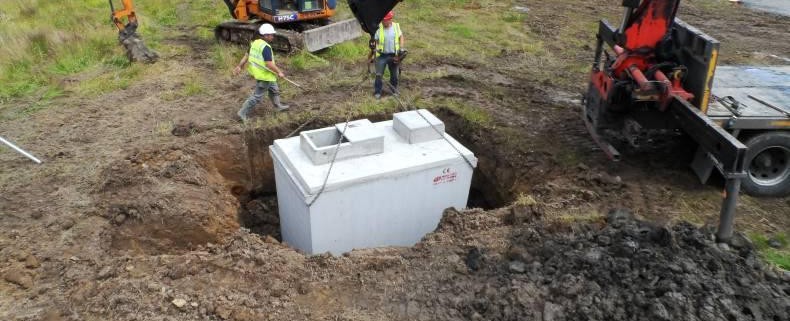Installing New Sewage Treatment Systems & the Cost Involved
Peter Varley talks to Diarmuid O’Reilly of O’Reilly Oakstown Environmental about installing new sewage treatment systems and the cost involved.
After the flooding this year it has become apparent that many septic tanks in rural areas are not working efficiently and may need upgrading. A septic tank is traditionally used for the primary treatment of sewage from most rural houses. Many older houses will only have a septic tank and some form of percolation area for sewage treatment but this is not always sufficient for treating sewage.
“In the septic tank the sludge settles, while the crust floats and the liquid or grey water moves on to the percolation area. Over 99.5% of all solids should be retained in the tank,” explained Diarmuid.
Sewage treatment takes place here via anaerobic digestion, generally breaking down the effluent by 30%. Diarmuid says that, typically, in older systems the grey water (partially treated sewage) goes to the percolation area where the soil is expected to do the remaining 70% of sewage treatment.
How the system should work
Diarmuid believes that a lot of Irish soils are unsuitable to carry out this level of sewage treatment and secondary treatment is usually required.
A secondary treatment system takes the partially digested water and feeds it to bacteria that break it down further.
There are many different types of secondary sewage treatment systems.
In Oakstown they use a three-chamber secondary treatment process to digest, clarify and then pump the water from the two primary chambers. In the bioreactors aerobic bacteria are cultured on durable netted plastic biomedia. This gives the microbes adequate surface to attach to while air is blown through the tubes from a low-watt blower sitting on top of the tank.
The air enters the tubes from the bottom of the tank and diffuses into millions of tiny bubbles, allowing the aerobic bacteria to thrive.
The inclusion of both air and grey water activates the bacteria to work on further breaking down the sewage via aerobic digestion, and making it less harmful to the environment.
The second chamber acts as a clarifier to periodically remove any solids which may get to that stage. The final chamber is the discharge area. Here a water pump moves treated sewage from the system to the percolation area. Diarmuid says up to 99% of the sewage treatment efficiency can be achieved after it goes through the combination of primary and secondary treatment.
Repairing an existing system
The main signs that a sewage treatment system is not functioning properly is water backing up in sewers and ponding around the percolation area. Sometimes it may be possible to fix a tank by fixing the T-bend where the waste enters the primary tank.
A properly functioning T-bend slows down the rate of movement of solids into the tank, reducing the splash effect in the tank so that a scum layer can form creating anaerobic conditions for waste water treatment.
Baby wipes should never be let into a tank because they cannot be broken down and cause blockages.
However, many old sewage treatment systems are beyond repair and are not fit for purpose. Some older tanks have structural cracks or the percolation system no longer works efficiently. Diarmuid believes these systems should be upgraded. Certainly, both septic tanks and sewage treatment systems should be desludged regularly.
Installing a new system
Planning permission is required when installing a new system but this is on the basis of a report from a soil engineer who will assess the site and recommend what type of treatment system is necessary.
A site assessment will determine whether or not a particular site can achieve the safe dispersal of wastewater from a development. Diarmuid says soil engineers carry out T-tests and P-tests. Very good soils that are efficient at treating grey water in a percolation area will typically have a T-test result of five to 20.
Extremely free-draining soils with a T-test result under five would likely require a secondary treatment system because partially treated sewage may make its way directly into groundwater or wells too easily.
On the other hand, wetter soils with a T-test over 20 would also be more likely to require secondary sewage treatment because in time there may be a risk of clogging in average to poor soils.
Cost
The cost depends on the size of household being serviced by the sewage treatment system. As a rule of thumb, to calculate the size of the septic tank required, multiply the number of people in the house by 150 litres (as a person uses 150 litres/day) and add 2,000 litres. For example, an eight-person house is (8 x 150) + 2,000 = 3,200 litres. Diarmuid says to service this household with a primary and secondary treatment system it would cost €3,500 including VAT. This includes installation costs, wiring, a low-watt air blower and water pump but, excludes a soil engineer assessment, planning permission and percolation area costs.
Grant Aid
Householders who have registered their system by the prescribed date of 1 February 2013 may be eligible for grant aid to repair or upgrade their system.
This grant aid is only available if an inspector finds problems with your treatment system and gives recommendations in an advisory notice.
Households with incomes of up to €50,000 per annum will be eligible to apply for a grant of 80% of approved costs, with a maximum grant payable of €4,000. Households with incomes of between €50,001 and €75,000 will be eligible for a grant of 50% of approved costs, with a maximum grant payable of €2,500. Households with incomes over €70,000 do not qualify for grant aid.
You cannot apply for grant aid unless you receive an inspection from your local authority and subsequently fail, and you cannot ask for an inspection.
By Peter Varley Farmers Journal 7th July 2016




